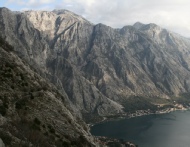“Boka is the name for that magical bay which craggy and almost inaccessible South Herzegovina and Montenegrin mountains descend to and sink into. Those who travel the world say that it occupies one of the most beautiful corners on the Earth; and I would indeed say that nature had been rather joyful when creating here its masterpiece in several iterations” (Stefan Mitrov Ljubiša)
Boka Kotorska is a unique Mediterranean bay – outstanding cultural landscape created by the harmonious symbiosis of natural phenomena and architectural heritage. Extremely favourable and specific natural and climatic conditions of the Bay had been decisive factors for inhabiting this area back in the earliest times, as well as for the building of towns and settlements in a distinct manner, which led to a unique harmony between natural creations and the creations of human spirit.
Morphological, geological and hydrological phenomena had made this area an exceptional natural creation of highest value in the Mediterranean basin, whose totality and anthropogenic component had given it global esteem. The area of the Bay is surrounded by the vertical slopes of dinaric-littoral limestone, with the highest peak of 1895 m above sea level (Mt. Orjen) and 52 m depth in the very Bay, which classify this area among rare holokarst in the world, with particularly pronounced karstic morphology and hydrology.
In such outstanding natural conditions, with the addition of geographical location and historical events, human hand in its uninterrupted activity has continuously created exceptional cultural properties under the influences of the cultures of the Mediterranean , of the West and partly also of the East, shaping them within the frameworks of particular way of life and understanding of life, spreading them to wider regions of the former Yugoslavia, Balkans, and even of the Eastern Europe, fitting them with exceptional sensitivity into the nature along the edge of the Bay, creating thus unique natural and cultural – human environment in the most humane way.
The towns, as well as bigger and smaller settlements around the Bay constitute distinct ensembles, creating an almost uninterrupted series. Every settlement obtains its own urban and cultural traits achieving, thus, the unity and continuity of the cultural heritage of the entire region. Their sacral architecture develops by merging different styles, Romanesque and Baroque in particular, while profane architecture creates a form of “Bokelian” house transposing the influences of the Mediterranean, of the West and the East through vernacular architecture. Elite profane architecture of the palaces occupies a significant place. Moreover, in Boka there are rich holdings and treasuries of moveable cultural heritage.
Boka Kotorska earned its place on the list of the Club of the Most Beautiful Bays of the World. Because of its outstanding universal cultural and natural values, one section of the Bay, the region of Kotor which includes both Kotor and Risan sections of the Bay, has been on UNESCO World Heritage List since 1979.
Prior to the arrival of the Slavs, as well as after, a large number of states, sovereigns or dynasts, yearned for Boka Kotorska, for this important strategic point in the southeast of the Adriatic, for its calm waters, where they would be able to shelter entire flotillas from the enraged sea or pirates, then for developed ancient towns, numerous naval settlements and picturesque villages. Various foreign or domestic rules were following one another not less than fifteen times, frontiers were being moved. However, it is only during several long-lasting rules that deeper changes were occurring in the historical destiny of this region.
During its history, Kotor had not always been the centre of the Bay. The town acquired its respectable position of a political, commercial and cultural centre, as reflected in the very name of the Bay, during the era of its comprehensive rise in the Middle Ages in particular. Formerly, during the Illyrian and Roman era, Risan had had full primacy, so that the whole of Boka was called “Risan Bay” (Sinus Rhisonicus). Herceg Novi is founded in the 14th century, and the settlements in its riviera are developed especially after the liberation of that section of the Bay from the Turks. In the period from the 16th to the 18th century, during the Venetian rule, Perast, Dobrota, Prčanj and Stoliv are developed, experiencing particular boom and acquire the status of maritime settlements. During Austro-Hungarian rule, Tivat becomes the principal navy base.
(sources: Nomination file for the inscription of the Natural Cultural-Historical Region of Kotor on UNESCO World Heritage List and Milošević Miloš, Historical Processes in the Region of the Bay)




















